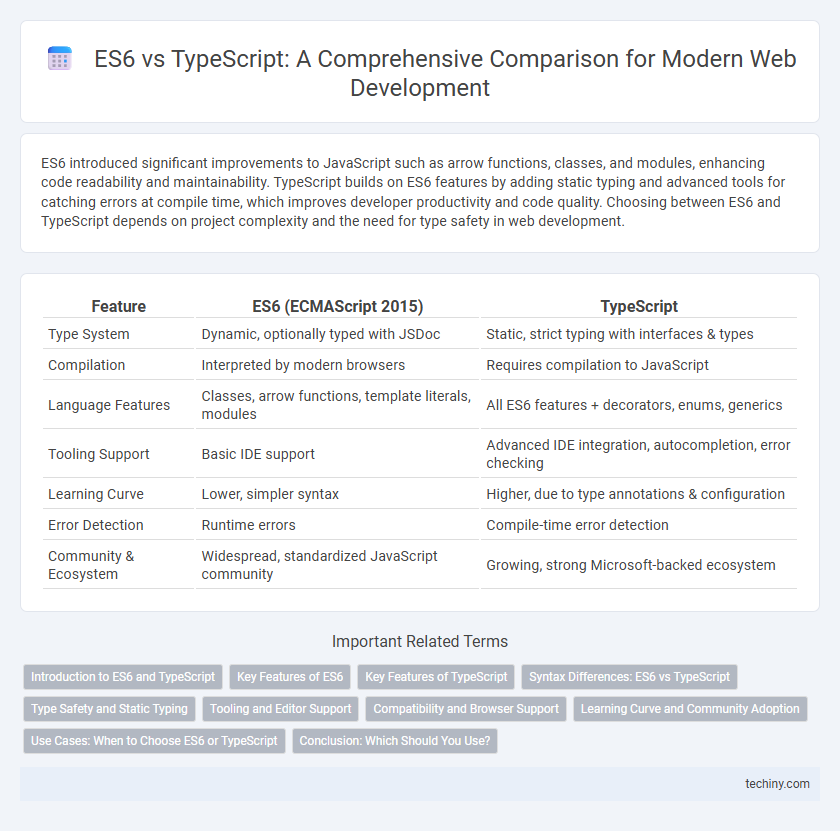ES6 introduced significant improvements to JavaScript such as arrow functions, classes, and modules, enhancing code readability and maintainability. TypeScript builds on ES6 features by adding static typing and advanced tools for catching errors at compile time, which improves developer productivity and code quality. Choosing between ES6 and TypeScript depends on project complexity and the need for type safety in web development.
Table of Comparison
| Feature | ES6 (ECMAScript 2015) | TypeScript |
|---|---|---|
| Type System | Dynamic, optionally typed with JSDoc | Static, strict typing with interfaces & types |
| Compilation | Interpreted by modern browsers | Requires compilation to JavaScript |
| Language Features | Classes, arrow functions, template literals, modules | All ES6 features + decorators, enums, generics |
| Tooling Support | Basic IDE support | Advanced IDE integration, autocompletion, error checking |
| Learning Curve | Lower, simpler syntax | Higher, due to type annotations & configuration |
| Error Detection | Runtime errors | Compile-time error detection |
| Community & Ecosystem | Widespread, standardized JavaScript community | Growing, strong Microsoft-backed ecosystem |
Introduction to ES6 and TypeScript
ES6, also known as ECMAScript 2015, introduced advanced JavaScript features like arrow functions, classes, template literals, and modules to enhance code readability and maintainability. TypeScript builds on ES6 by adding static typing, interfaces, and advanced tooling support, enabling developers to catch errors early and improve scalability in large-scale web applications. Both technologies play crucial roles in modern web development, with ES6 providing core language improvements and TypeScript offering enhanced robustness and developer productivity.
Key Features of ES6
ES6, also known as ECMAScript 2015, introduces key features such as arrow functions, let and const for block-scoped variable declarations, template literals, default parameters, and destructuring assignments, which enhance code readability and maintainability. Classes and modules provide a standardized approach to object-oriented programming and modular code structure in JavaScript. Promises and enhanced object literals improve asynchronous programming and object manipulation, making ES6 a foundational update for modern web development.
Key Features of TypeScript
TypeScript extends ES6 by adding static typing, interfaces, and advanced type inference, enabling early detection of errors during development. It supports modern JavaScript features, including classes and async/await, while introducing decorators and namespaces for better code organization. Enhanced tooling with autocompletion and refactoring capabilities in editors significantly improves developer productivity and code maintainability.
Syntax Differences: ES6 vs TypeScript
ES6 introduces modern JavaScript syntax enhancements such as arrow functions, template literals, and destructuring, streamlining code development with native features. TypeScript extends ES6 by adding static typing, interfaces, and type annotations, enabling early error detection and improved code maintainability. The added syntax for types in TypeScript ensures robust code quality while maintaining compatibility with existing ES6 modules and syntax.
Type Safety and Static Typing
TypeScript offers enhanced type safety over ES6 by introducing static typing, which detects type errors during compilation, reducing runtime bugs. Unlike ES6, which relies on dynamic typing in JavaScript, TypeScript's static type annotations enable better code predictability and maintainability. This early error detection streamlines development workflows and improves overall code quality in large-scale web applications.
Tooling and Editor Support
TypeScript offers superior tooling and editor support compared to ES6, providing advanced features like static type checking, autocompletion, and real-time error detection that enhance development efficiency and code quality. Popular IDEs such as Visual Studio Code natively support TypeScript, enabling seamless integration of refactoring tools and debugging capabilities. While ES6 benefits from widespread compatibility and syntax support in modern editors, TypeScript's enhanced tooling is a decisive advantage for large-scale web applications requiring maintainable and robust codebases.
Compatibility and Browser Support
ES6 introduced modern JavaScript features like modules and arrow functions that are natively supported in most current browsers, ensuring broad compatibility without transpilation. TypeScript, a superset of JavaScript, compiles down to ES5 or ES6, enhancing compatibility by targeting older browsers while offering static typing and advanced developer tools. Choosing between ES6 and TypeScript affects browser support strategies, with TypeScript providing a more robust solution for maintaining compatibility across diverse environments.
Learning Curve and Community Adoption
ES6 introduced modern JavaScript syntax and features like arrow functions and modules, making it easier for developers to write cleaner code with a moderate learning curve. TypeScript builds on ES6 by adding static typing and advanced tooling, resulting in a steeper learning curve but improved code reliability and maintainability. Community adoption of ES6 is widespread due to its native support in modern browsers, while TypeScript has rapidly gained popularity among large-scale projects and enterprises seeking scalable codebases.
Use Cases: When to Choose ES6 or TypeScript
ES6 is ideal for projects requiring modern JavaScript features with minimal setup, suitable for small to medium-scale applications or when rapid prototyping is needed. TypeScript excels in large-scale, complex applications where static type checking, better tooling support, and improved maintainability are critical. Choosing TypeScript enhances code quality and reduces runtime errors in enterprise-level projects, while ES6 offers simplicity and faster development for less complex codebases.
Conclusion: Which Should You Use?
ES6 provides modern JavaScript features that enhance coding efficiency and readability, making it suitable for simpler projects and quick development cycles. TypeScript offers static typing and advanced tooling, improving code quality and maintainability in complex applications and large teams. Choosing between ES6 and TypeScript depends on project scale, team expertise, and the need for robust error checking during development.
ES6 vs TypeScript Infographic

 techiny.com
techiny.com